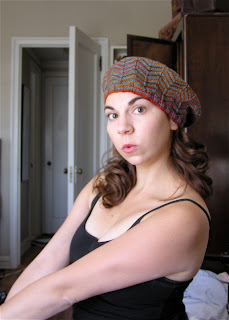I had a request from a fellow Raveler to provide a chart of the fair isle pattern I used for my Nautical Fair Isle baby cardigan. I'm happy to oblige. This is not a full-on sweater pattern but just a chart of the colorwork and a few pointers for anyone wanting to make a nautical fair isle garment.
The Chart (click to enlarge):
The Pointers:
As I wrote on the chart, because each band of peeries has a different-sized repeat, you need to do a little math as you go along.
- If you're making a cardigan, make sure that each row of picture elements is evenly spaced from your button bands. This means that you should have the same number of "blank" stitches before the first goldfish, boat, or wave and after the last one. So, for example, if my cardigan body (which I am knitting in one piece from left front to right front) has 100 stitches, for my goldfish row I would divide 100 by 10 (the pattern repeat). Here it would seem that all I have to do is work 10 repeats of the peerie, but that would mean that the first fish starts right up at the button band and the last fish has three "blank" turquoise stitches between its nose and the button band. So, in fact, I need to work 9 repeats and spread the remaining 10 stitches out evenly between the beginning and end so that the first and last fish are evenly spaced with regard to the button band. So first I will work 3 stitches before my first fish to parallel the three "blank" stitches at the end of the last pattern repeat. That leaves 7 stitches to divide between them. I'll add 3 stitches before the first repeat and 4 after the last one (a difference of one stitch is not a big deal). That means that my goldfish row will work like this: k6 in turquoise, work 9 repeats of goldfish peerie, k4 in turquoise. In terms of what it will actually look like, though, the band will have 6 turquoise stitches, then 9 goldfish, then end with 7 turquoise stitches. Repeat this kind of calculation with the other peerie rows.
- If you are knitting a pullover, you'll have to increase and decrease a little bit to make up for the difference in pattern repeats. So if, again, I were working on a 100-stitch body section, I would work 25 repeats of the zigzag, 10 repeats of the goldfish, decrease by one stitch (to 99 stitches) to work 11 repeats of the sailboats, increase by three stitches (to 102 stitches) to work 17 repeats of the waves, then decrease by 2 to get back to 100. A difference of 1-4 stitches up or down from that 100-stitch body count is not going to be noticeable, especially after blocking.
- I knit my nautical fair isle cardigan top-down, using my favorite recipe for top-down raglan baby cardigans. If you choose to do so, just flip the fair isle chart upside down!
- Similarly, you can work this pattern on the yoke of a sweater. A normal circular-yoke sweater increases (if you're going top-down) or decreases (if you're going bottom-up) by 4 evenly-spaced stitches every row/round (or 8 every other, or 16 every fourth, or 24 every sixth, etc). So you can hide your increase/decrease rows in the solid-color rows as follows: increase/decrease by 8 in row 1; by 8 in row 4; by 24 in row 10; by 32 in row 18; by 8 in row 20; by 8 in row 22; by 16 in row 26.
Enjoy! And avast, ye land-lubbers!









5 comments:
So cute. All my grands are too old for baby sweaters. Alas.
Arrrr
And your math explains why the ill-fated tulip cardi doesn't have the same number of flowers on each side.
Doesn't matter, 'cause it's not worn, but still . . . for the hedgehogs, I'll need it.
I love the little ships and fish! They are so cute, not to mention colorful.
That is so cute!
I am in awe of your thrift store sweater fix.
baby cobblestone is so cute and beautiful! Great work as usual.
Post a Comment